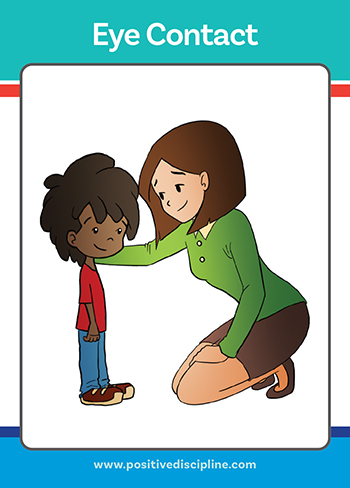
As parents and teachers, we are constantly looking for effective ways to connect with young children and grow our relationships. One tool that might seem simple but can make a huge impact is eye contact. It’s a powerful way to engage with children, build trust, and create a connection. Let’s dive into why eye contact is so important and how you can use it to foster meaningful interactions with kids.
Why Eye Contact Matters
Young children are incredibly sensitive to their surroundings. They constantly absorb information from the world around them, so when we communicate across the room or give commands from a distance, it can be hard for them to focus and respond because we are on the periphery. Eye contact helps draw their attention to us, making them feel seen and heard. It’s a way to show them that we’re truly present in the moment and are prioritizing this connection.
When you make eye contact with a child, you’re not just directing their attention—you’re also letting them know you care. You’re building that deep felt sense connection that helps them feel understood and safe. As the late Toni Morrison once said, “Do your eyes light up when they walk into the room?” That’s the kind of presence we should aim for when we interact with children.
The Power of Nonverbal Communication
Sproutable's Early Years Lead, Julietta Skoog, introduces the Positive Discipline Early Childhood Educator tool cards. This episode focuses on the Eye Contact tool card both in the classroom and at home. Julietta shows how to use this important tool to connect with young children at an age when they are very sensitive and attuned to adults. She breaks down why it matters and offers strategies for the home and classroom.
As parents and teachers, we are constantly looking for effective ways to connect with young children and grow our relationships. One tool that might seem simple but can make a huge impact is eye contact. It’s a powerful way to engage with children, build trust, and create a connection. Let’s dive into why eye contact is so important and how you can use it to foster meaningful interactions with kids.
Why Eye Contact Matters
Young children are incredibly sensitive to their surroundings. They constantly absorb information from the world around them, so when we communicate across the room or give commands from a distance, it can be hard for them to focus and respond because we are on the periphery. Eye contact helps draw their attention to us, making them feel seen and heard. It’s a way to show them that we’re truly present in the moment and are prioritizing this connection.
When you make eye contact with a child, you’re not just directing their attention—you’re also letting them know you care. You’re building that deep felt sense connection that helps them feel understood and safe. As the late Toni Morrison once said, “Do your eyes light up when they walk into the room?” That’s the kind of presence we should aim for when we interact with children.
The Power of Nonverbal Communication
Eye contact is just one aspect of nonverbal communication, but it plays a big role. Our body language—like the way we smile, how we relax, and how we position ourselves—speaks volumes. A relaxed and warm demeanor invites respect, encourages positive interactions, and lets children know that we’re there for them.
Children are incredibly perceptive. They can sense when we’re truly engaged and when we’re not. By being mindful of our eye contact and overall body language, we create an environment where they feel supported and validated.
Practical Tips
Here are a few practical ways you can incorporate eye contact into your daily interactions with young children:
Get on Their Level: When you kneel down or sit face-to-face with a child, it’s easier to make eye contact and establish a connection. This sends the message “I see you.”
Be Present: Don’t just look at them as a passive gesture—truly engage. For example, when a child tells you a story, make eye contact and say, “Tell me more about what happened.” This shows that you’re genuinely interested and encourages them to open up.
Use Eye Contact for Encouragement: When a child accomplishes something, like cutting out a shape or playing carefully, use eye contact to reinforce their effort. A simple, “I can see how careful you were with that shape,” accompanied by a smile, will go a long way in making them feel proud.
Build Connection During Difficult Moments: Sometimes, children may feel distant or upset. In those moments, placing your hand on their shoulder and maintaining eye contact can be incredibly soothing. A question like, “Are my eyes still brown?” can shift their focus to your eyes and invite them to feel more grounded.

